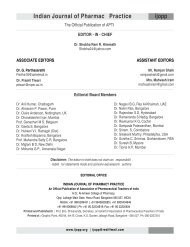Jul-Sep, 2012 - Indian Journal of Pharmacy Practice
Jul-Sep, 2012 - Indian Journal of Pharmacy Practice
Jul-Sep, 2012 - Indian Journal of Pharmacy Practice
Create successful ePaper yourself
Turn your PDF publications into a flip-book with our unique Google optimized e-Paper software.
Ramesh A - Prospective Monitoring and Reporting <strong>of</strong> Adverse Drug Reactions associated with Antiplatelet and Antiepileptic Drugs in a South <strong>Indian</strong> Tertiary Care Teaching Hospitalrash(3), fixed drug eruptions(1), dizziness(2), insomnia(1),somnolence(2)]. Valproic acid had caused 13 ADRs [weightincrease (5), abnormal behavior (2), fatigue (1), menstrualdisorder (1), dizziness (1), liver function test abnormality (1),somnolence (2)]. Carbamazepine had caused 4 ADRs [ataxia(2), dizziness (1), lethargy (1)]. Phenobarbitone had caused 2ADRs [abnormal behavior (1), gum hyperplasia (1)]. Tremorwas developed in one patient while increasing the dose <strong>of</strong>Levetiracetam.Many research studies have corroborated the phenytoin may15,16cause the gingival hyperplasia. Despite having highincidence <strong>of</strong> gingival hyperplasia with phenytoin, patients arestill recommended with phenytoin because <strong>of</strong> economicconsiderations. Valproic acid is reported to cause weight17gain hepatic and renal damage, syndrome <strong>of</strong> inappropriateanti diuretic hormone hypersecretion (SIADH) in patients. Inour study, weight gain was observed in 5 patients. In suchcases, the strategy adopted to decrease the weight was dietcounseling and life style modifications to the patients.The ADRs involved with Aspirin use were Urticaria (6)Gastric ulcer (8) and gastrointestinal bleeding (1) and withClopidogrel use were Rash (4), Angioedema (2), Headache(3), and constipation (5).Among the ADRs developed by antiepileptic agents thehighly affected organ system class is Gastro intestinaldisorders followed by Central peripheral nervous systemdisorders. Among ADRs developed by antiplatelet agents thehighly affected organ system class is Gastro IntestinalDisorders followed by skin and appendages disorder.No change in the treatment was observed in 50 cases as thoseADRs were mild and self limiting in nature. Even thoughthere was no overdose situation among the study population,10 patients improved when dose was altered. Medicationswere discontinued in 14 patients as the ADRs were so severelike gastrointestinal bleeding, liver damage, anticonvulsanthypersensitivity syndrome etc.Majority <strong>of</strong> patients did not receive any treatment for theADRs because either these reaction were mild and selflimiting in nature or there is no specific or symptomatictreatment for some reactions. Also among few cases, patientswere not ready to withdraw the drug as the benefit from thedrug (phenytoin) was outweighing the risk and the alternativedrug was more costly than the existing one. As the studyduration was only for nine months we could able to reportonly few reactions. Long duration study will help us in findingthe incidence, prevalence, and predisposing factorsinfluencing the occurrence <strong>of</strong> ADRs.CONCLUSIONIn the present study, Phenytoin and Valproic acid attributed tomajority <strong>of</strong> adverse drug reactions in antiepileptic class.Aspirin attributed for majority <strong>of</strong> ADRs in antiplatelet class <strong>of</strong>medications. The organ system classes affected was centralnervous system (antiepileptic agents) Gastrointestinal system(Antiplatelet agents) and Skin (antiepileptic agents andAntiplatelet agents).ACKNOWLEDGEMENTWe sincerely thank the JSS University, Dr. H.G Shivakumar,Principal, and Dr. G Parthasarathi, Head, Department <strong>of</strong><strong>Pharmacy</strong> <strong>Practice</strong>, JSS College <strong>of</strong> <strong>Pharmacy</strong>, Mysore andalso the Medical Superindent, JSS Hospital for theirencouragement and support.REFERENCES:1. International drug monitoring: the role <strong>of</strong> national centers.Report <strong>of</strong> a WHO meeting. World Health Organ Tech Rep Ser.1972;498:1-25.2. Michae DF, Gary SF. Adverse drug reactions in patients withcardiovascular diseases. Curr Probl Cardiol. 2008;33:703-768.3. Ramesh M. Drug therapy review. In: Parthasarathi G, NyfortHansen K, Nahata MC, Editors. A Textbook <strong>of</strong> Clinicalst<strong>Pharmacy</strong> <strong>Practice</strong>- Essential Concepts and Skills: 1 ed.Chennai; Orient Longman Private Limited, 2004,p.218-2354. L.M Shish. Epidemiology and etiology <strong>of</strong> seizures and epilepsyin the elderly in Asia. Neurology Asia. 2004; 9(supplement1):31-32.5. Sridharan R. and Murthy B.N. Epilepsy. IBID.1999;40:631-6366. Vicky B.G, Hays R.D, Rausch R et.al. Quality <strong>of</strong> life <strong>of</strong> epilepsysurgery patients as compared with our patients withhypertension, Diabetes, Heart disease, and/or depressivesymptoms. Epilepsia.1994;35:597-607.7. Naranjo C.A, Busto U, Sellers EM. Comparision <strong>of</strong> twoalgorithms for assessing the probability <strong>of</strong> adverse drugreactions. Br J Clin Pharmacology.1982;13:223-227.8. Mayboom RH, Hekster YA, Egberts AC, Gribnau FW andEdwards IR. Causal or Casual, The role <strong>of</strong> causalityassessment in pharmacovigilance. Drug Saf. 1997;17(6):374-89.9. Hartwig SC, Siegel J, Schneider PJ. Preventability and severityassessment in reporting adverse drug reactions. Am J HospPharm 1992; 49: 2229-32.10. Shumock GT, Thornton JP, Witte WK. Comparison <strong>of</strong>pharmacy-based concurrent surveillance and medical recordretrospective reporting <strong>of</strong> adverse drug reactions. Am J HospPharm. 1991;48:1974–6.<strong>Indian</strong> <strong>Journal</strong> <strong>of</strong> <strong>Pharmacy</strong> <strong>Practice</strong> Volume 5 Issue 3 <strong>Jul</strong> - <strong>Sep</strong>, <strong>2012</strong> 23
















